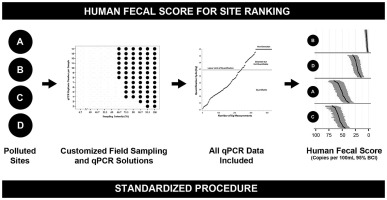当前位置:
X-MOL 学术
›
Water Res.
›
论文详情
Our official English website, www.x-mol.net, welcomes your
feedback! (Note: you will need to create a separate account there.)
A human fecal contamination score for ranking recreational sites using the HF183/BacR287 quantitative real-time PCR method.
Water Research ( IF 11.4 ) Pub Date : 2017-10-31 , DOI: 10.1016/j.watres.2017.10.071 Yiping Cao 1 , Mano Sivaganesan 2 , Catherine A Kelty 2 , Dan Wang 3 , Alexandria B Boehm 3 , John F Griffith 1 , Stephen B Weisberg 1 , Orin C Shanks 2
Water Research ( IF 11.4 ) Pub Date : 2017-10-31 , DOI: 10.1016/j.watres.2017.10.071 Yiping Cao 1 , Mano Sivaganesan 2 , Catherine A Kelty 2 , Dan Wang 3 , Alexandria B Boehm 3 , John F Griffith 1 , Stephen B Weisberg 1 , Orin C Shanks 2
Affiliation

|
Human fecal pollution of recreational waters remains a public health concern worldwide. As a result, there is a growing interest in the application of human-associated fecal source identification quantitative real-time PCR (qPCR) technologies for water quality research and management. However, there are currently no standardized approaches for field implementation and interpretation of qPCR data. In this study, a standardized HF183/BacR287 qPCR method was combined with a water sampling strategy and a novel Bayesian weighted average approach to establish a human fecal contamination score (HFS) that can be used to prioritize sampling sites for remediation based on measured human waste levels. The HFS was then used to investigate 975 study design scenarios utilizing different combinations of sites with varying sampling intensities (daily to once per week) and number of qPCR replicates per sample (2-14 replicates). Findings demonstrate that site prioritization with HFS is feasible and that both sampling intensity and number of qPCR replicates influence reliability of HFS estimates. The novel data analysis strategy presented here provides a prescribed approach for the implementation and interpretation of human-associated HF183/BacR287 qPCR data with the goal of site prioritization based on human fecal pollution levels. In addition, information is provided for future users to customize study designs for optimal HFS performance.
中文翻译:

使用 HF183/BacR287 定量实时 PCR 方法对娱乐场所进行排名的人类粪便污染评分。
人类粪便对娱乐水域的污染仍然是全世界公共卫生问题。因此,人们对将人类粪便源识别定量实时 PCR (qPCR) 技术应用于水质研究和管理越来越感兴趣。然而,目前还没有用于现场实施和 qPCR 数据解释的标准化方法。在本研究中,标准化的 HF183/BacR287 qPCR 方法与水采样策略和新颖的贝叶斯加权平均方法相结合,建立了人类粪便污染评分 (HFS),该评分可用于根据测量的人类排泄物确定修复采样点的优先顺序水平。然后,HFS 用于调查 975 个研究设计方案,利用不同的位点组合、不同的采样强度(每天到每周一次)和每个样本的 qPCR 重复次数(2-14 次重复)。研究结果表明,使用 HFS 进行位点优先排序是可行的,并且采样强度和 qPCR 重复次数都会影响 HFS 估计的可靠性。这里提出的新颖的数据分析策略为人类相关 HF183/BacR287 qPCR 数据的实施和解释提供了规定的方法,其目标是根据人类粪便污染水平进行站点优先级排序。此外,还为未来用户提供定制研究设计以获得最佳 HFS 性能的信息。
更新日期:2017-11-01
中文翻译:

使用 HF183/BacR287 定量实时 PCR 方法对娱乐场所进行排名的人类粪便污染评分。
人类粪便对娱乐水域的污染仍然是全世界公共卫生问题。因此,人们对将人类粪便源识别定量实时 PCR (qPCR) 技术应用于水质研究和管理越来越感兴趣。然而,目前还没有用于现场实施和 qPCR 数据解释的标准化方法。在本研究中,标准化的 HF183/BacR287 qPCR 方法与水采样策略和新颖的贝叶斯加权平均方法相结合,建立了人类粪便污染评分 (HFS),该评分可用于根据测量的人类排泄物确定修复采样点的优先顺序水平。然后,HFS 用于调查 975 个研究设计方案,利用不同的位点组合、不同的采样强度(每天到每周一次)和每个样本的 qPCR 重复次数(2-14 次重复)。研究结果表明,使用 HFS 进行位点优先排序是可行的,并且采样强度和 qPCR 重复次数都会影响 HFS 估计的可靠性。这里提出的新颖的数据分析策略为人类相关 HF183/BacR287 qPCR 数据的实施和解释提供了规定的方法,其目标是根据人类粪便污染水平进行站点优先级排序。此外,还为未来用户提供定制研究设计以获得最佳 HFS 性能的信息。









































 京公网安备 11010802027423号
京公网安备 11010802027423号